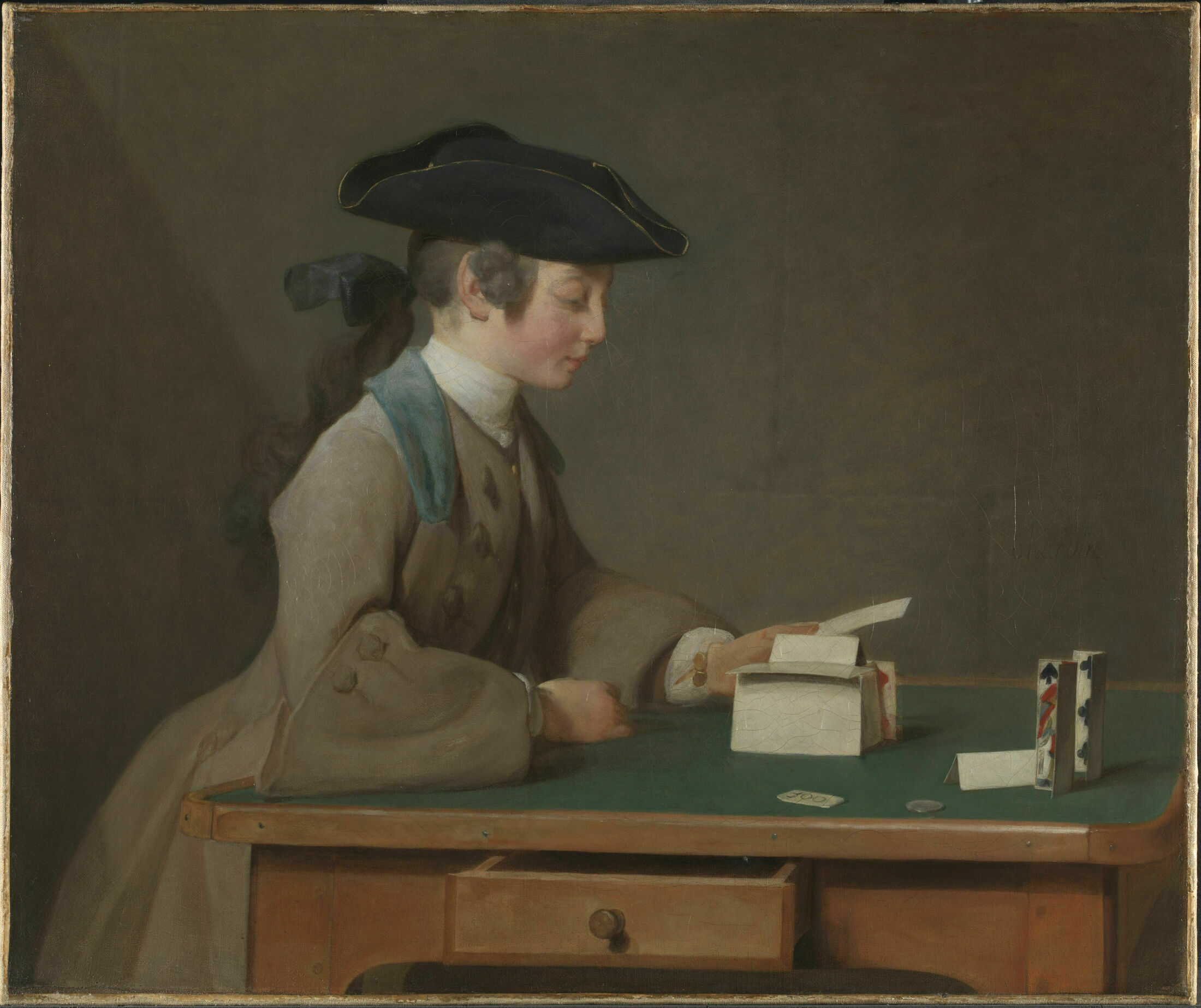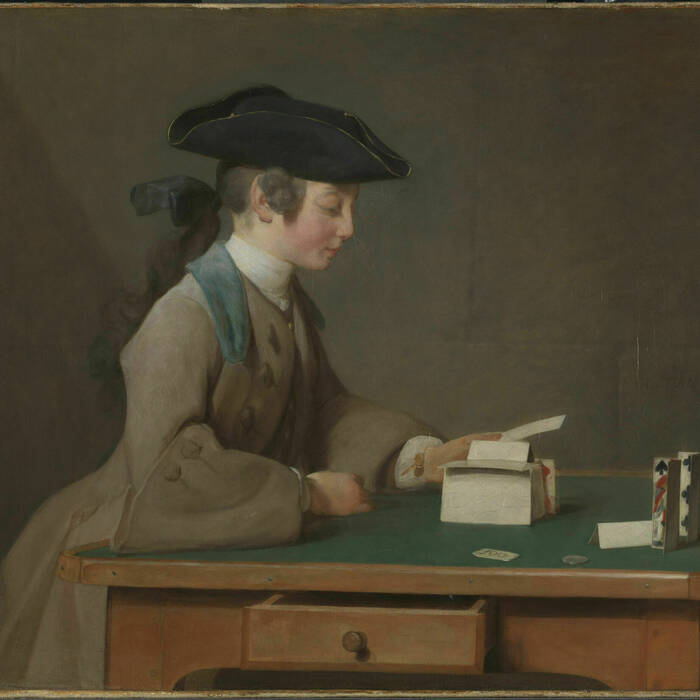The National Gallery Masterpiece Tour | Jean-Siméon Chardin
The House of Cards
Oriel Davies Gallery kicks off The National Gallery Masterpiece Tour by presenting Chardin’s The House of Cards (1740-41) alongside two new commissions creating a dialogue between the 1700s and present day.

Jean-Siméon Chardin’s The House of Cards (about 1740–1) from the National Gallery’s Collection, is travelling the UK in 2021 and 2022.

The picture has been chosen for the first year of the National Gallery’s three-year Masterpiece partnership with Oriel Davies Gallery(Newtown, Powys, Wales), the Beacon Museum (Whitehaven, Cumbria) and Carmarthenshire Museum (Abergwili, Carmarthen). The National Gallery Masterpiece Tour 2021–23 offers three non-London museums, galleries or art centres the opportunity to partner with the National Gallery for three years and to display one different major work from the collection each year.
Oriel Davies Gallery kicks off the National Gallery Masterpiece Tour by presenting Chardin’s The House of Cards alongside two new commissions. A kinetic work by the artist Charlie Cook, which will examine the concept of the ‘fragility of human endeavour’ and the idea of playful persistence as shown in the loaned painting.
A graduate of Glasgow School of Art, Charlie Cook uses cabinet making skills to create kinetic works that playfully explore balance.
Building a Future, a collaboration between Oriel Davies, local communities and illustrator Alyn Smith. The Cardiff‐based artist has been commissioned to create a set of 15,000 cards which will be completed by contributions from local communities and built in the gallery exploring the relationship between dreaming and reality through play.
Steffan Jones‐Hughes, Director of Oriel Davies, said: ‘We’re delighted to have this opportunity to work with the National Gallery and show historical work from the collection as a starting point for a contemporary dialogue with artists and our audiences, making connections between the work and Newtown’s people and places.’
National Gallery Director Dr Gabriele Finaldi said: ‘Caught somewhere between curiosity, determination and fragility, the boy in Chardin’s painting is engrossed in his house-of-cards construction. The host museums have conceived some highly original and intensely participatory approaches to how this picture will be displayed in the context of their spaces and collections and I much look forward to working closely with them to reach new audiences outside London.’
This picture is one of four identified versions of The House of Cards painted by Chardin. It is most likely the last version he painted and was probably exhibited at the Salon of 1741.
A young boy stands at a small wooden table, which is covered with green baize. Leaning forward slightly with his forearms resting on the tabletop, he is fully absorbed in the task of constructing a house out of playing cards. The first storey has already been completed and he is about to begin the second. The boy is Jean-Alexandre Le Noir, whose father, Jean-Jacques Le Noir, was a furniture dealer and cabinet-maker. A close friend of Chardin, who had witnessed the artist’s marriage in 1744, Jean-Jacques Le Noir had commissioned several paintings from him, including a portrait of Madame Le Noir (now lost and known only from an engraving).
The theme of a child building a house of cards was familiar to Chardin’s contemporaries from 17th- and 18th-century images, which were often accompanied by moralising verses. When an engraving of Chardin’s painting was made by François-Bernard Lépicié in 1743, the caption under the image included the lines: ‘Dear child on all pleasures bent / We hold your fragile work in jest / But think on’t, which will be more sound / Our adult plans or castles by you built?’ But even without the addition of the verse, the symbolism of the delicately balanced cards – signifying the fleeting and fragile nature of human endeavour – would have been clear.
Cards were also associated with gambling, but this does not appear to be Chardin’s concern here, despite the presence of a chip and a coin on the table. These seem to be of no interest to the boy (who anyway does not have a companion with whom to gamble) and were most likely left over from an earlier game of piquet. Nor does the boy have any interest in the value of the cards themselves. Indeed, he is looking at the blank reverse of the card he is holding. As stated in the catalogue of the 1741 Salon, the boy is simply ‘enjoying himself making a house of cards.’
The fact that this house of cards is only one storey high may be of significance. Contemporary paintings of this theme typically show the cards to be two or more storeys high – and thus at greater risk of collapse. It has been suggested that the incomplete house could be a metaphor for the child, who is not yet an adult. But there may also be more immediate family associations. As a maker of fine furniture, Monsieur Le Noir may have hoped that his son would follow him into the business. The boy’s card building is perhaps not just a game but may also be an exercise in methods of construction. ‘Noir’ means black in French, and the prominent display of two upright folded black suit cards (the spade and club) – whose tripartite shapes echo the boy’s black tricorne hat – is perhaps intended to suggest an association between the Le Noir family name and a profession based upon creating structures that will endure.
The National Gallery is one of the greatest art galleries in the world. Founded by Parliament in 1824, the Gallery houses the nation’s collection of paintings in the Western European tradition from the late 13th to the early 20th century. The collection includes works by Bellini, Cézanne, Degas, Leonardo, Monet, Raphael, Rembrandt, Renoir, Rubens, Titian, Turner, Van Dyck, Van Gogh and Velázquez. The Gallery’s key objectives are to enhance the collection, care for the collection and provide the best possible access to visitors. More at nationalgallery.org.uk
You are welcome to drop in to visit us during our opening hours, however there may be a queue if we are at capacity.
We therefore advise using our Free booking system to avoid queuing and book a 1-hour timed visiting slot.
